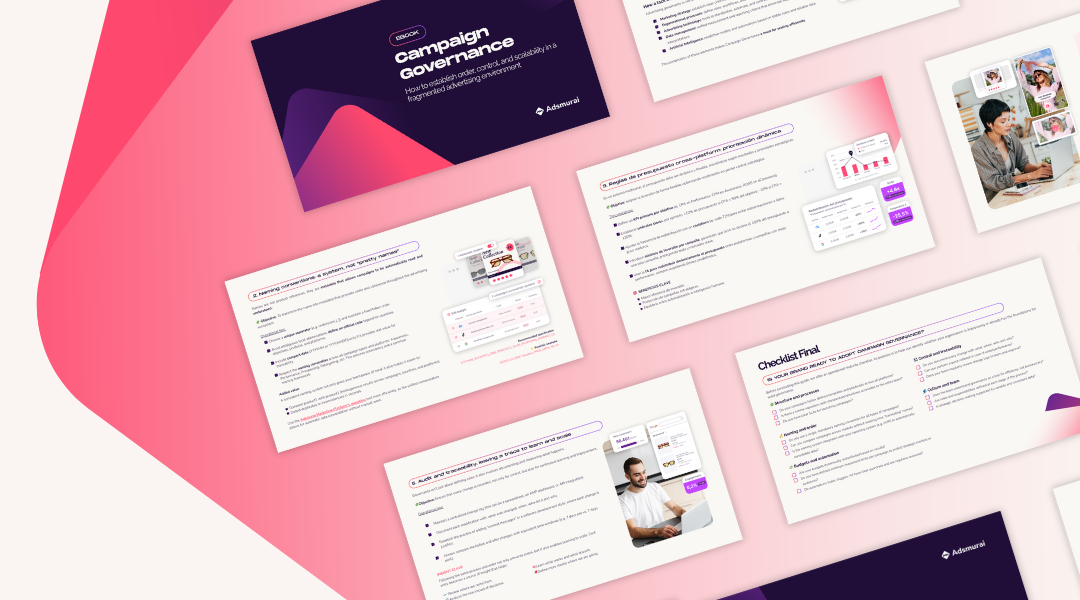Discover Meridian: Google's tool to measure what really matters in your media mix
Let’s be clear: measuring the performance of your campaigns today is a risky business. With the disappearance of cookies, increasingly strict privacy...
Plan, activate and control media to hit targets with precision.
Turn data into smart decisions with advanced analytics and modeling.
Efficiency, governance and scale for agencies and teams.

[Ebook] Campaign Governance - How to establish order, control, and scalability in a fragmented advertising environment
Learn how to move from the chaos of scattered campaigns to an organized, scalable, and efficient system. Everything explained in an eBook your future self will thank you for.
Discover more
In the popular landscape of data privacy and user consent, staying on top of technological advances and regulatory changes is crucial for businesses. One development that demands attention is Google Consent Mode, a tool designed to navigate the complexities of user consent in the digital realm. In this article, we will delve into the nuances of Google Consent Mode, emphasizing its importance, evolution and the upcoming Google Consent Mode V2, with a crucial implementation deadline of March 2024.
TABLE OF CONTENTS
The evolution of consent in the digital world has experienced significant milestones, from the early days of simple cookie banners to the precise definitions established by regulations such as the GDPR and the DMA. The General Data Protection Regulation (GDPR) laid the groundwork for explicit and informed user consent, emphasizing the importance of clarity and user awareness of data processing activities on websites.
In the context of user consent and data privacy, the Digital Markets Act (DMA) has emerged as a key piece of regulation in the European Union. This legislation, which came into force in November 2022 in the European Union and the European Economic Area, strengthens and extends the provisions of the GDPR. The MAD is designed to address anti-competitive practices and the unbridled power of large technology platforms, known as gatekeepers.
The passage of the new DMA in 2023, effective March 2024, puts the onus on large companies like Google to collect and act on user consent. In response, Google announced the new version of Consent Mode called Google Consent Mode V2.
Google Consent Mode emerges as a strategic response to the changing landscape of user consent and privacy regulations. It is a tool designed to align Google products with the specific consent choices made by website users. This alignment ensures that organizations can effectively measure conversions on their websites without violating user consent with respect to advertising or analytics cookies.
Key features of Google Consent Mode include the ability to detect and adjust Google tags based on user consent signals. It allows organizations to balance marketing efforts and user privacy. In cases where users reject certain cookies, their data is anonymized, ensuring compliance with privacy regulations.
Google Consent Mode operates by integrating with a Consent Management Platform (CMP), which manages the acceptance or rejection of cookies by users. It is crucial to note that Consent Mode is not a CMP, but complements the existing system. The tool works by detecting user consent signals received directly from the CMP pop-up window. Depending on the user's consent status, Google Consent Mode adapts the operation of Google products.
It is important to note that Consent Mode requires gtag.js or Google Tag Manager for proper functionality. Users with older tags such as ga.js or analytics.js should upgrade to gtag.js or Google Tag Manager before enabling Consent Mode.
As the regulatory landscape continues to evolve, Google has introduced Consent Mode V2, requiring immediate action by advertisers. This enhanced version increases control over data usage and introduces new parameters such as "ad_user_data" and "ad_personalization". These parameters play a crucial role in audience building and remarketing, respecting users' choices regarding personalized ads.
Consent Mode V2 offers two implementation modes: Basic and Advanced. Basic mode blocks Google tags until users give consent, while Advanced mode loads the tags before the consent banner is displayed, sending cookie-free pings when consent is refused.
Important note: The deadline for implementation of Consent Mode V2 is March 2024. It is essential that organizations prepare and update their configurations before this date to ensure continuity of their online operations.
Google Consent Mode V2 is not just a feature, but a paradigm shift in consent management. It ensures that advertisers can continue to serve ads to consenting users, with the addition of IP anonymization for enhanced security. The new version introduces advanced consent signals, enabling more nuanced control over data usage and sharing.
Services facilitated by Consent Mode include Google Analytics, Google Ads (conversion tracking and remarketing), Floodlight and Conversion Linking. Implementation can be either Advanced or Basic, depending on the user's interaction with the CMP banner.
Consent Mode plays a vital role in controlling the behavior of statistical and marketing cookies on websites. For Google Analytics 4, it adjusts data collection according to the user's individual consent choices, ensuring compliance with privacy preferences. Similarly, for Google Ads, Consent Mode governs the behavior of marketing cookies, adapting to the user's consent status and enabling contextual ads based on anonymized data.
Mastering Google Consent Mode is imperative for organizations looking to navigate the intricate landscape of user consent, privacy regulations and digital marketing. The transition to Google Consent Mode V2 is not just a compliance requirement; it represents a strategic move toward user-centric data practices in an era where privacy takes center stage. Adapting to these changes ensures that companies can continue to leverage digital platforms for effective marketing while respecting user choices and regulatory mandates.
In this context, Adsmurai offers its expertise through its Data team. Our team has specialized in the implementation of Consent Mode in order to enable intelligent data delivery to optimize analytics and campaigns. We offer a solid and legally compliant strategy to empower your online operations, in compliance with the Data Protection Act.
Don't lose valuable data due to missing cookies. With the help of our team, we guarantee an accurate and efficient implementation of Consent Mode, ensuring that your digital marketing strategy is based on solid data and respects current privacy regulations.

Let’s be clear: measuring the performance of your campaigns today is a risky business. With the disappearance of cookies, increasingly strict privacy...

Until recently, measuring in Google Ads was quite simple: a user clicked on an ad, made a purchase, and… done, attributed. But the digital ecosystem...

In a recent decision that marks a significant shift in Google's privacy policy, the company has announced that it will keep third-party cookies...